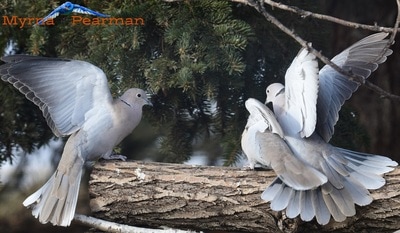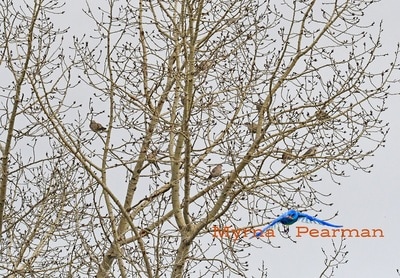 Who knew that a lowly dove would hold the title for being the fastest spreading invasive bird species ever recorded in North America? Even the rapid dispersal of our continent’s two most famous and insidious invaders – House Sparrows and European Starlings – pales in comparison to the speed with which the Eurasian Collared-Dove has spread since it was first documented in Miami, Florida in 1982. These birds arrived on U.S. soil via the Bahamas, where some individuals escaped from a pet shop during a mid-1970s burglary. The shop owner then released the rest of his stock – about 50 birds. Apparently, there was another release of individuals on the island of Guadeloupe in 1976, just before a forecasted volcanic eruption. It took these doves only a decade to spread all the way from Florida to Alaska. Their dispersion has followed a northwesterly direction, with the most rapid expansion following along a southeast-to-northwest path between the two areas. Less than 100 years after we drove Passenger Pigeons to extinction, these birds arrived and began to multiply with abandon. Who knows, perhaps we will once again see "a feathered tempest,” which is how Aldo Leopold described the flocks of Passenger Pigeons that were once so large they literally darkened the skies. Judy Boyd, coordinator for the Central Alberta Christmas Bird Count (CBC), reports that Eurasian Collared-Doves were first documented in Central Alberta in 2005, with nine individuals counted. CBC records for the subsequent years are as follows: four in 2006; three in 2009; five in 2010 and 2011, nine in 2012 and four in 2013. Their numbers have increased significantly over the past three years: 16 in 2014, 23 in 2015, 20 in 2016. Eurasian Collared-Doves are so named because their nape is ringed by a black half-collar. They are quite large and can be easily distinguished from our only native dove, the summer-dwelling Mourning Dove, by their larger size, squarish tail, black collar and distinctive, rhythmic three-parted coo. Their other vocalization is a loud hwaah sound, which they issue when they are excited, alarmed and just before they land. Eurasian Collared-Doves prefer highly modified landscapes over forested landscapes. This preference means that they are typically found around human habitation, not in more remote or natural habitats. However, as they increase in number, they may spread into more natural/rural areas. At a feeding station, they will dine on sunflower seeds (they gobble the seed, shell and all), wild bird mixes, millet, milo, wheat and cracked corn. They tend to feed together as a group, then fly off to a communal roosting area where they rest before returning to feed again. It appears that these birds are non-migratory, choosing to remain year-round in their newly settled regions. Although they are obviously hardy, many of the birds that I have photographed exhibited severely frost-bitten toes (either stubs or festering sores on their feet), an obvious ravage of extremely cold temperatures to which they have not yet become acclimatized. As with all invasive species, there is concern that this new invader will outcompete or displace native dove species. However, early research done by the Cornell Lab of Ornithology using Project FeederWatch data in Florida concluded that the abundance of native dove species was actually higher at sites with collared-doves than at sites without them. While the birds may not yet have had a negative impact in tropical areas, their interaction with native species in northern areas remains to be seen. Initial observations of Alberta birds indicate that they appear to feed fairly well with other species and will feed quietly together as a group on a tray feeder. However, aggressive behaviour is sometimes observed between two individual birds vying for space. One bird may fly into a feeder and attempt to knock the other one away, or the two birds will each undergo dramatic wing displays as they attempt to sort out who’s boss. I would be interested in hearing from other feeder watchers who are now (willingly or unwillingly) hosting these birds. What are your observations? Feel free to email me with details [email protected] THIS JUST IN: I received this email from John and Jane Ferguson of Red Deer who read my column today about these birds: We read with interest your article in the Red Deer Advocate on Eurasian Collared Doves. In the Summer of 2002 we noticed strange dove type birds nesting in our yard, in the Oriole Park part of Red Deer. I could not find any info in Canadian books but in a Bird book of North America I did find a listing on the Eurasian Collard dove which looked like what I seen. Being family friends with Ron Bjorge of Alberta Wildlife we passed this info on to him , Ron also looked at these birds and thought that may be what we are looking at. A visit shortly after by a Biologist from Alberta Wildlife assured our find. He did film the birds at the time , and I believe a count of nine was correct. The parents and Seven young. They had nested in one of our trees that year. This was in Early July of 2002. Later on we were contacted and told that this was the first official sighting in Alberta. Only bettered a year earlier in Saskatchewan. I have dug out an old photo album to check the pictures I have, to what dates we had listed. Thank you for the article as it brings back many exciting memories of the sighting. |
AuthorMyrna Pearman Archives
August 2022
|
All photos and published works on this website are copyright Myrna Pearman unless otherwise noted.
Re-posting these images or publishing is not permitted without Myrna's written consent.
Copyright Myrna Pearman Publishing 2024- Site design and maintenance by Carolyn Sandstrom
Re-posting these images or publishing is not permitted without Myrna's written consent.
Copyright Myrna Pearman Publishing 2024- Site design and maintenance by Carolyn Sandstrom







 RSS Feed
RSS Feed



17/1/2017
0 Comments